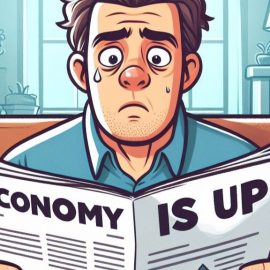

This article is an excerpt from the Shortform book guide to "Think Like a Monk" by Jay Shetty. Shortform has the world's best summaries and analyses of books you should be reading.
Like this article? Sign up for a free trial here .
What does it mean to truly be happy? Is your definition of happiness being skewed by external sources?
Former monk and life coach Jay Shetty argues that people’s idea about what makes them happy are skewed by society and social media. Rather than seeking validation from others, Shetty says that you should seek happiness through defining and following your values in life.
Continue reading for more Think Like a Monk book advice from Shetty.
Mental Shortcuts Create False Images of Happiness
In his book Think Like a Monk, Jay Shetty claims that, throughout your life, you’ve been influenced by the various opinions and expectations of your family, friends, culture, and media. You learned early on that, to get along well with others, you needed to conform to their expectations of you.
- For example, you noticed that your parents were more affectionate when you got perfect grades. You unconsciously made the connection in your mind that perfect grades led to affection. More affection made you happy, therefore, you associated having perfect grades with being happy.
Shetty argues that various similar experiences led you to unconsciously conclude that your happiness depends on what you think other people think of you. As a result, you’re now so preoccupied with what other people think about you that you’ve developed different personas and tailored your behaviors to fit different situations and expectations: your professional work persona, your loving mom persona, your sociable friend persona, and so on.
| Seeking External Validation Leads to Inauthentic Behavior Research in the area of authenticity confirms Shetty’s claim that many people base their happiness on how they think others perceive them. Further, psychologists agree that you’re more likely to feel happy when you act authentically and confidently present your “true self” to the world. On the other hand, you’re more likely to feel unhappy when you seek external validation and act inauthentically to conform to what you think others want from you. The research confirms that feelings of discomfort and inauthentic behavior go hand-in-hand. In other words, you can figure out if you base your happiness on what others think of you and are prone to adopting different personas by asking yourself if you have the tendency to feel: -Embarrassed by things you’ve done or said -Awkward and self-conscious in daily interactions -Resentful and misunderstood -Afraid of what others think of you -Rejected and unheard These feelings reflect and encourage inauthentic behavior and feelings of unhappiness. For example, sometimes shy people come across as loud and overbearing. This is because their discomfort around others leads them to overact to compensate for their shyness. As a result, they find themselves adopting a gregarious persona to mask their shyness (thus acting inauthentically). This leads them to question whether people like them for who they are or for the act they put on. As a result, they feel more uncomfortable about interacting with others and this encourages more inauthentic behavior. |
You Don’t Know What Makes You Happy
According to Shetty, these mental shortcuts encourage you to focus on what you need to do to receive a certain reaction from the outside world so that you can live up to what you think others want from you. This preoccupation with pleasing others distracts you from thinking about how you feel, what your unique needs are, and, most importantly, what makes you happy.
(Shortform note: Another way to think about this is to consider the difference between intrinsic and extrinsic motivation. Some experts believe that all behavior is driven by the need to fulfill one of two motivation types: intrinsic and extrinsic. Intrinsic motivation comes from your internal self—you engage in an activity because you find it rewarding (for example, you listen to a particular song because you enjoy it—you act based on what makes you happy). Extrinsic motivation comes from your environment—you engage in an activity because you receive an external reward for doing it (for example, you pretend to like a particular song because you’re afraid of feeling left out of your social group—you act based on what others want from you).)
Satisfaction and Happiness Come From Having Clear Values
According to Shetty, who you are and what you need to feel satisfied and happy can be summed up by your values. Your values are core beliefs that you choose to live by—they determine who you want to be and how you treat yourself and others. Your values shape how you think, color your perceptions, motivate your behavior, and guide your decisions.
Shetty claims that values allow you to understand the meaning underlying everything you do and that your ability to find meaning in what you do is directly linked to how satisfied you feel. Consequently, he argues that the degree to which you live in alignment with your values determines how meaningful your life experiences feel to you.
(Shortform note: In Awaken the Giant Within, Tony Robbins also argues that life feels more meaningful when you live in alignment with your values. He adds weight to Shetty’s definition of values by distinguishing between two different types: Ends—these are the emotional states you want to experience, such as love or happiness. Means—these are the ways you expect to reach the ends. For example, you value family life because it’s a means to the end of experiencing love and happiness. You may find it useful to consider these two types of values throughout this section of the guide.)
Shetty says that the clarity of your values has a direct impact on your ability to experience satisfaction and happiness in three ways:
1) Yielding to External Pressures Creates Unclear Values
When you’re preoccupied with chasing false images of happiness—by conforming to and pleasing others—you end up accumulating other people’s values and pursuing things that you think will make you happy. However, while your different personas enable you to navigate and perform in accordance with the various values you’re influenced by, you don’t stop to consider if any of these values align with your inner values. Consequently, Shetty argues, you’re unable to understand or appreciate the meaning behind what you’re doing, or to gain any real satisfaction once you get the things you’ve been chasing.
(Shortform note: Tony Robbins (Awaken the Giant Within) clarifies why living up to the values of others makes life feel unmeaningful. He argues that accumulating other people’s values inevitably leads you to adopt a number of conflicting values that create confusion and frustration. Imagine you’ve unconsciously adopted the values of independence and intimacy but you haven’t identified why these values are important to you, or in what areas of your life you want them to guide you. So, in relationships, you struggle between wanting to connect and yearning to be untethered because you haven’t consciously decided what values you need to feel fulfilled in this area.)
2) Unclear Values Create an Overactive Mind
Shetty notes that when you engage in behaviors that don’t feel meaningful to you, your dissatisfaction with what you’re experiencing makes you more prone to distractions. Your thoughts wander aimlessly between various external influences and make you feel like you’re constantly being pulled in multiple directions. The more you fill your mind with random and distracting thoughts, the less space you have to reflect upon what’s personally important and meaningful to you.
(Shortform note: Like Shetty, Mihaly Csikszentmihalyi, author of Flow, argues that your mind becomes disordered and chaotic when you experience feelings of dissatisfaction. He explains that when you don’t value what you’re experiencing, you find it difficult to focus your attention on the present moment. However, your mind wants to focus on something, so it seeks external stimulation to occupy your thoughts. In contrast, if what you’re doing feels meaningful to you, you find it easier to focus your attention and feel absorbed in it. This sense of absorption makes it difficult for your mind to wander and get distracted by random thoughts.)
3) An Overactive Mind Encourages Negative Tendencies That Fuel Dissatisfaction
According to Shetty, overactive and unfocused thoughts tend to sway towards the negative—fears, complaints, comparisons, criticisms, envy, judgment, anger, insecurities, and so on—and magnify the negative aspects of every experience (how you think about yourself, your experiences, and those around you).
This negative mental clutter leads to feelings of overwhelm, confusion, and anxiety, and is both the cause and symptom of feeling unhappy and dissatisfied: Your thoughts are unfocused and unproductive so you feel dissatisfied. You feel dissatisfied so find it difficult to prevent your mind from focusing on and amplifying thoughts that make you feel even more uncomfortable. Shetty claims that this mental pattern blinds you to what you need to feel satisfied and leads you to waste your time with people and situations that don’t support your values. Ultimately, this pattern leaves you trapped in a cycle of dissatisfaction.
| Why You’re Prone to Thinking Negatively Research backs up Shetty’s claim that, if your thoughts are unfocused, they’re probably negative. Psychologists refer to this tendency to notice and dwell on negative experiences as the Negativity Bias. They explain that negative experiences have a greater emotional impact on you than positive ones. In other words, negative experiences feel more important to you than positive ones. Subsequently, negative events create a strong and vivid impression in your long-term memory, and they influence the types of thoughts that fill your mind—you’re more likely to notice, react to, and remember: -Criticism more than praise -Sad memories more than happy memoriesBad news more than good news -Your mistakes more than your successes -Negative traits in others more than their positive traits It’s possible that evolution hard-wired this bias into us to keep us safe from danger: In order to ensure survival, our ancestors had to pay more attention to the dangers and risks in their environment. However, even if it is a case of hardwiring, psychologists agree that you can make the conscious decision to bypass this tendency, evolve your thinking, and adopt a more positive approach to life, thus escaping the cycle of negativity and dissatisfaction that Shetty describes above. |

———End of Preview———
Like what you just read? Read the rest of the world's best book summary and analysis of Jay Shetty's "Think Like a Monk" at Shortform .
Here's what you'll find in our full Think Like a Monk summary :
- Tips from a former Vedic monk on how to find happiness and fulfillment in life
- The three stages to adopting the monk mindset
- How to positively influence the world around you






